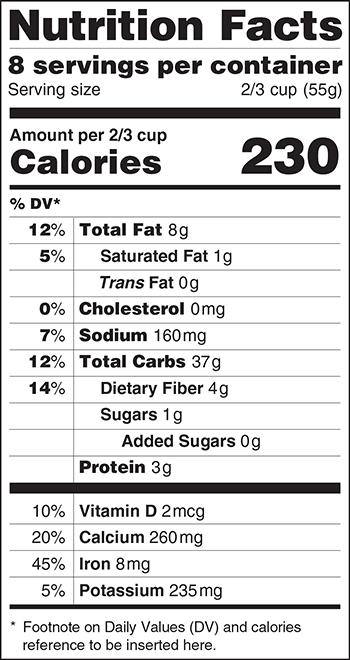by Gabriella Agostinelli
For the first time in two decades, the FDA has proposed significant changes to nutrition labeling. The agency’s proposed nutrition labels will affect all packaged foods except meat, poultry and processed egg products, which are regulated by the Department of Agriculture rather than the FDA.

Proposed Label
The proposed changes include:
- Serving sizes will be updated.
Serving sizes would more accurately reflect the amounts people actually eat, rather than what they should eat. The proposal modifies the serving size in about 17 percent of the 150 categories of packaged food. For example, a 20 oz. bottle of soda would constitute one serving, rather than the 2.5 servings currently listed. Ice cream servings would increase from half-cup to a more realistic one-cup serving.
- “Added sugars” will be incorporated into the labels.
After the 2010 Dietary Guidelines for Americans stated that intake of added sugar is too high in the U.S. population and should be reduced, the FDA has included a separate line on the label to alert consumers of any added sugars.
- Calories from fat will be removed.
Studies now show that the type of fat matters more to our health than the number of calories from fat. Labels for unsaturated, saturated, trans and total fat will remain.
- Daily values for nutrients will be revised.
To better reflect current nutrition knowledge, several daily value estimates will change, including sodium and fiber. For example, the agency may reduce the daily recommendation on sodium from 2,400 mgs to 2,300.
- Vitamin emphasis will shift.
Vitamins A and C will be replaced by Vitamin D and potassium, as many Americans are not getting enough of these important nutrients.
- Key nutrition data will be highlighted.
The proposed label format emphasizes elements such as calories, serving sizes and Percent Daily Value, as they are vital in addressing current public health problems like obesity and heart disease.
- For larger packages, a new dual column format would be required.
The agency has proposed “dual column” labels to indicate both “per serving” and “per package” calorie and nutrition information for larger packages that could be consumed in one sitting or multiple sittings.
So far, reviews have been mixed regarding the value of these changes. Critics suggest that only a small portion of Americans actually pay attention to the proposed labels, which would cost the food industry an estimated $2 billion. Supporters of the proposed rule maintain that the changes will improve consumer awareness, incentivize producers to make their food products more healthful, and lead to smarter food purchasing decisions by consumers.
The proposal is open to public comment until June 2, 2014, and months will pass before the final rule is announced. Once a rule is finalized, food companies will have two years to put the changes into effect.

















